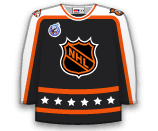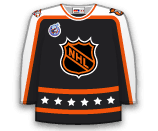Pelletier is 30-years-old and in his first season back in North America since 2009-10. He spent the last three years in the Swiss-A league. In 39 games with Utica this season he has nine goals and 30 assists (39 points). He will play for the injured Chris Higgins.
NHL Hockey Player News
Ebbett has appeared in seven games this season for Pittsburgh, collecting one assist. He has 15 points (6G / 9A) in 18 games with WBS this year.

Moser made his NHL debut on Saturday vs. St. Louis before getting sent down on Sunday. He is back with the Predators and could get in the lineup on Thursday. He has eight goals and 17 assists (25 points) in 40 games with Milwaukee this season.
Thomas averaged 7:11 TOI and was a minus-1 with one shot in two games with the Habs. With Montreal trading away a defenseman for a forward (Dale Weise) today, Thomas' services were no longer required.

Vatanen registered 14 points (6G / 8A) in 39 games with the Ducks this season. He had one goal and five assists in six games while he was with Norfolk.

Ortio has played 25 games with Abbotsford this season. He is top five in the AHL in all goaltending categories with a 19-5 record (2nd) for a .792% winning percentage along with a .930% save percentage (3rd) and a 2.08 GAA (4th).

Jaskin has one goal in six games with the Blues this season. When in the AHL he has recorded 13 goals and 12 assists (25 points) with a plus-11 rating in 32 games.

Ward went 1-1 with a 2.02 GAA and .937 SV% in two AHL games for the Checkers during his conditioning stint. He has missed the Hurricanes’ last 14 games due to a lower-body injury and the conditioning assignment. Prior to the injury, Ward had posted a 6-7-5 record, a 3.15 GAA and an .895 SV% in 19 games with Carolina this season.

McCarthy had one assist with a minus-12 rating in 35 games with the Sharks.

Steckel has appeared in four games with the Ducks this season and will likely play in a few more after Nick Bonino was injured on Thursday. Steckel has four goals and nine assists (13 points) in 32 games with the Admirals.

After trading away Mark Fraser on Friday, the Maple Leafs had an open roster spot, the filled that by recalling McKegg. He was the Leafs third round pick (#62 overall) in 2010. He is currently in his second season with the Marlies where he finds himself at 26 points (9G / 17A) in 35 games. If he is able to crack the lineup tonight, it will be his NHL debut.

Stoa did not dress for a game during his call-up. He was recalled as insurance for Brooks Laich, who was available for Tuesday and Thursday's contests.
With Mike Green unlikely to play tonight in Detroit, Strachan has been recalled and will slide into Green's spot if he is unavailable. Strachan has no points in nine games with the Capitals this season, but has picked up 14 points (2G / 12A) in 34 games with Hershey.

Thomas is in his first season with the Habs organization after coming over from the Rangers. He has 14 points (5G / 9A) in 23 games with Hamilton this season.

VandeVelde recorded one assist, eight shots, six penalty minutes and a minus-3 rating in 17 games with the Flyers. His assignment opens a roster spot for Zac Rinaldo to be activated from IR.

Ward will join the Checkers in Cleveland as they face the Lake Erie Monsters on Friday. Ward has missed the Hurricanes last 13 games with a lower-body injury. He has posted a 6-7-5 record, a 3.15 GAA and an .895 SV% in 19 games with Carolina this season. Ward is the Hurricanes franchise’s all-time leader in games played by a goaltender (450), wins (220) and shutouts (21). His last AHL stint was in December 2005, when he played two games with the Lowell Lock Monsters during a conditioning stint.

With Chris Tanev out until after the Olympics with a broken thumb, Corrado has been recalled to serve as the team's seventh defenseman. He has no points in six games with the Canucks this season, but has seven points (3G / 4A) in 36 games with Utica.

Jones cleared waivers this afternoon and has been sent to the AHL. He was a plus-1 in four games during his most recent time with the Flames. He has a total of two goals in 14 games wit Calgary and returns to the AHL where he has eight goals and 13 assists (21 points) in 16 games.

Jeffrey has one assist in 12 games with the Stars this season. During his time in the AHL he was held off of the scoresheet in two contests.

With Lubomir Visnovsky being activated from IR on Monday, Donovan had to be sent down, but this morning they placed Travis Hamonic (concussion) on IR so Donovan is back. He will serve as the team's eighth defenseman, but will likely see some action as Matt Carkner and Radek Martinek typically shuffle in and out of the lineup.
